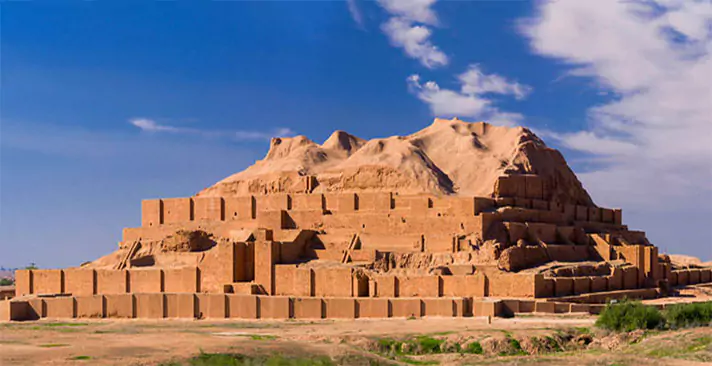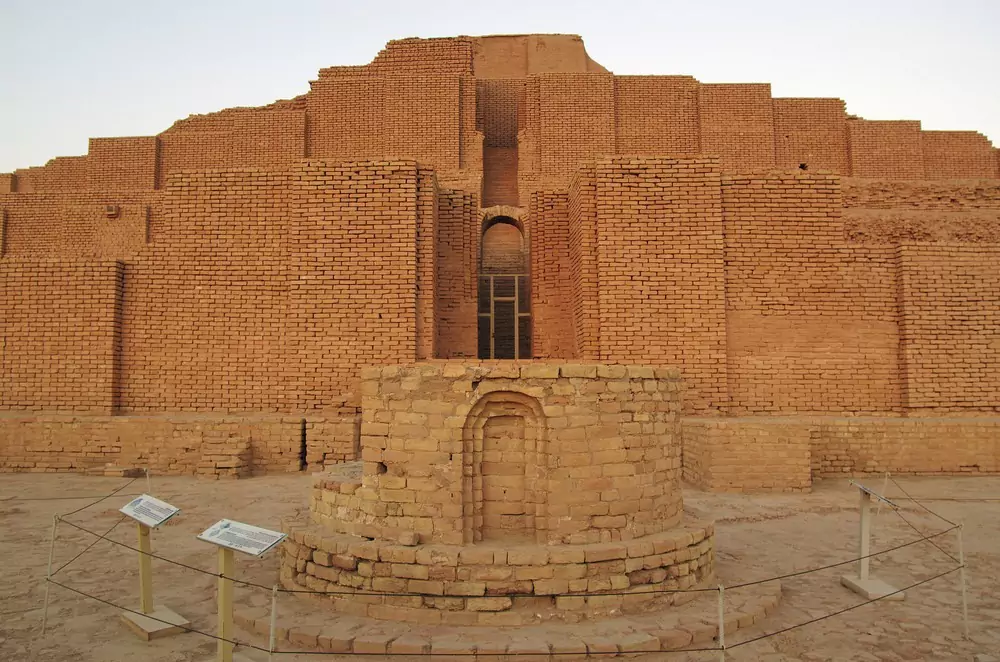Chogha Zanbil, a UNESCO World Heritage Site, stands as a testament to the ingenuity and grandeur of the ancient Elamite civilization in Iran. This archaeological marvel, with its towering ziggurat and intricate temples, offers a captivating glimpse into a rich history. It dates back to the 13th century BC. Furthermore, located in the Khuzestan province, Chogha Zanbil invites you to explore its fascinating ruins. Come uncover the secrets of a lost world.
Unveiling the Mysteries of Chogha Zanbil
The name “Chogha Zanbil” translates to “basket mound.” This aptly describes the site’s most prominent feature: a massive ziggurat. It once soared towards the heavens. This ancient structure, dedicated to the Elamite god Inshushinak, is one of the few ziggurats found outside Mesopotamia. Moreover, it is the largest of its kind in Iran.
The Ziggurat: A Monumental Masterpiece
King Untash-Napirisha built the ziggurat of Chogha Zanbil around 1250 BC. It is a remarkable feat of engineering and architecture. Indeed, builders constructed it with mud bricks and faced it with baked bricks. The ziggurat was originally five stories high, although only three remain today. Its square base measures 105 meters on each side. Previously, it reached a height of 52 meters.
The ziggurat’s interior is a labyrinth of corridors and chambers. Some of these were used for religious rituals and ceremonies. Consequently, archaeologists have uncovered numerous artifacts within the ziggurat. These include inscribed bricks, pottery, and cylinder seals. Essentially, these artifacts provide valuable insights into Elamite culture and religion.
Temples and Palaces: Centers of Worship and Power
The remains of several temples surround the ziggurat. Each temple was dedicated to a different Elamite deity. The temple of Inshushinak is the most significant of these. It was located at the top of the ziggurat. In addition, other temples within the complex honored the goddesses Kiririsha and Pinikir.
Chogha Zanbil also features the ruins of three palaces. Elamite kings and their families likely used these palaces. They showcase the opulence and sophistication of Elamite architecture. For instance, the palaces feature courtyards, reception halls, and private chambers. Intricate decorations and murals adorn them.
Exploring the Ancient City of Dur Untash
Chogha Zanbil was not just a religious center. Instead, it was also a thriving city known as Dur Untash. Three concentric walls surrounded the city. These provided protection and defined its urban layout. Within the city walls, archaeologists have discovered residential areas, workshops, and a sophisticated water management system.
The Royal Quarter: A Glimpse into Elamite Royalty
The area between the first and second walls of Dur Untash housed the royal quarter. The Elamite kings and their court resided here. Specifically, this area contained palaces, administrative buildings, and royal tombs. Murals and inscriptions richly decorate the tombs. As a result, they offer valuable insights into Elamite burial practices and beliefs about the afterlife.
The Sacred Precinct: A Place of Worship and Ritual
The innermost wall of Dur Untash enclosed the sacred precinct. Here stood the ziggurat and temples. This area was reserved for religious activities. Only priests and high-ranking officials could access it. Therefore, the sacred precinct was a place of pilgrimage for the Elamites. They came from across the kingdom to worship their gods and participate in religious festivals.
Chogha Zanbil: A Window into Elamite Civilization
Chogha Zanbil is more than just an archaeological site. It is a window into the fascinating world of the Elamite civilization. The Elamites were a non-Semitic people. They inhabited southwestern Iran from the late 4th millennium BC to the 6th century BC. During this period, they developed a unique culture and language. Their kingdom played a significant role in the ancient Near East.
Elamite Culture and Religion
The Elamites were skilled artisans and craftsmen. They produced exquisite pottery, jewelry, and metalwork. Their art often depicted religious scenes and mythological creatures. This reflects their complex belief system. Specifically, the Elamite pantheon included a variety of gods and goddesses. Inshushinak, the god of Susa, was the most prominent.
The Legacy of the Elamites
The Elamite civilization left a lasting legacy on the region. They influenced the art, architecture, and religion of neighboring cultures. For example, later civilizations adopted their sophisticated water management systems and urban planning techniques. Similarly, their artistic traditions continued to inspire generations of artists.
Visiting Chogha Zanbil: Practical Information and Tips
Address: Chogha Zanbil, Khuzestan Province, Iran
Estimated Opening Hours: 9:00 AM to 5:00 PM daily
Contact Information: +98 61 3333 3031 (Chogha Zanbil Archaeological Site)
Getting There:
- By Car: Chogha Zanbil is located approximately 30 km southeast of Susa and 80 km north of Ahvaz. The site is accessible by car via well-maintained roads.
- By Bus: Buses run regularly from Susa and Ahvaz to the nearby town of Haft Tappeh. You can hire a taxi to Chogha Zanbil from Haft Tappeh.
Best Time to Visit:
The best time to visit Chogha Zanbil is during the cooler months, from October to April. However, summers in Khuzestan can be extremely hot. This makes outdoor activities uncomfortable.
Tips for Visitors:
- Dress modestly: Chogha Zanbil is an archaeological site with religious significance. Therefore, it is important to dress modestly. Cover your shoulders and knees.
- Wear comfortable shoes: You will walk a lot on uneven terrain. Thus, comfortable shoes are essential.
- Bring sunscreen and a hat: The sun can be strong, even in the cooler months. Consequently, protect yourself from sunburn.
- Hire a guide: A knowledgeable guide can enhance your visit. They can provide insights into the history and significance of the site.
- Respect the site: Chogha Zanbil is a fragile archaeological site. Above all, please be respectful. Avoid touching or climbing on the ruins.
Precautions:
- Photography: Photography is allowed at the site. However, the use of tripods may be restricted in certain areas.
- Food and drinks: There are limited facilities at the site. Therefore, it is advisable to bring your own food and drinks.
- Accessibility: The site has limited accessibility for people with disabilities. Contact the site in advance to inquire about accessibility options.
Plan Your Journey to Chogha Zanbil Today!
Chogha Zanbil offers a unique opportunity. Step back in time and experience the wonders of the ancient Elamite civilization. Explore the majestic ziggurat. Wander through the ruins of temples and palaces. Uncover the secrets of a lost world. Ultimately, book your trip today. Embark on an unforgettable journey through history.









